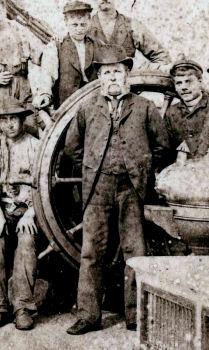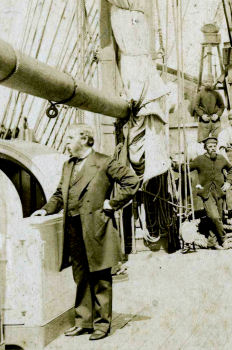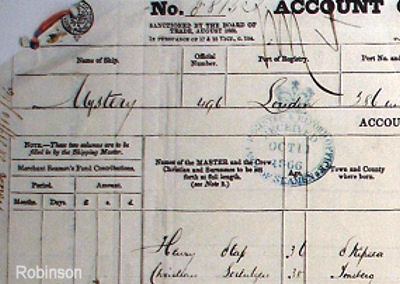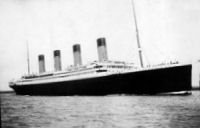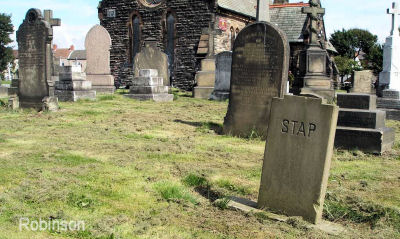The
Titanic was launched launched May 1911, completed in 1912 and registerd in
Liverpool, England . At he time the ship was the largest in the world, 822 feet[269m]
long, so over twice the length of the Great Britain. The registered tonnage
was 46,328 GRT.Titanic
set from Southampton for New York on its maiden voyage on Wednesday 10th April
1912 with 2,223 people on board.
Four days later at 11,40 PM on Sunday 14th April the ship struck an iceberg and
sank at about 2,20 AM on the 15th. Only 710 people, less than a third of those
on board survived. The rest of the story is history but less well-known is how
the Titanic's captain, Edward John Smith was a good friend of Henry Stap
and the two had met shortly before the fateful departure. |
Birkenhead News Saturday 4
May 1912 THE
EXPERIENCES OF A BIRKENHEAD STEWARDESS MISS
STAP'S GRAPHIC ACCOUNT OF THE DISASTER There
arrived in Birkenhead on Wednesday evening, Miss Sarah Stap of 41 Bidstan Avenue,
Cloughton, one of the survivors of the ill-fated Titanic. Miss Stap
held the responsible position of senior stewardess on board the vessel and had
been transferred from the sister ship, Olympic. Our representative
visited Miss Stap yesterday morning at her residence in Bidston avenue and to
him she imparted a most thrilling and vivid narrative of the wreck of the vessel.
She did not betray the least excitement, or nervousness, but her pale wan face
indicated at once the terrible suffering she had passed through. "how do
you feel after your experiences?" enquired our representative."not at
all well." replied Miss Stap, "although I am very much better than I
have been. I am really not my old self yet. It has been a dreadful time, and seems
to have been all a most horrible nightmare. I cannot yet realise that the beautiful
ship has gone for ever, for she was a magnificent ship. We (I mean the crew) were
all so radiantly happy together when we left Southampton on Wednesday, the 10th
April. There was no ceremony whatever when we moved off from the pier, and that
is what I think makes the disaster all the more sad, it seems almost as if we
were too happy. "Everything went well until the fatal night of the 14th."
Here Miss Stap
paused a while as if the terrible spectacle was once more being enacted."Where
were you, Miss Stap, when the accident occurred?" "I was in bed and
was awakened by a slight bump. It would then have been about a quarter to twelve
at night. I did not take very much heed of the noise at first, because I had been
used to a ship's bumping before. In fact I thought that something or other had
gone wrong in the engine room." "Did you get up from your bed?"
"No, presently I heard the night watchman pass my door and I called out to
him "What's the matter?" He replied, "Oh, we have only touched
a bit of ice. I think it is alright, I don't think it is anything." "It
was three quarters of an hour after I felt the ship bump that I got up and when
I reached the deck the lifeboats had been ordered out. 'What did you feel like?'
"I was not in the least frightened. I was simply stunned. Perfect order prevailed
and everybody seemed calm and collected. The passengers would not believe that
we had struck an iceberg, but I myself knew what had happened. The officers and
crew behaved magnificently, as did also the dear old captain." "Did
you see Mr. Ismay at all?" "Oh yes, he was on deck in his pyjamas and
a coat, vainly endeavouring to get the passengers into the boats. They (the crew)
had the utmost difficulty in trying to persuade the people to get into the boats.
I think it is most unfair the stories that have been circulated about Mr. Ismay.
He worked might and main all the time, and I did not think he actually realised
that the ship was sinking. It is my own impression that more lives would have
been saved if only the people could have been persuaded to enter the boats more
quickly, I was helped into the last boat but one and had charge of a baby, whose
father and mother were lost. There were no less that 72 or 77 persons in our boat
and I nursed the little mite for several hours. Although the night was starry,
it was bitterly cold and everyone was nearly starved. "How long were you
in the boat?" "About six hours. I shall never forget it until my dying
day. There we were all huddled up together. It was awful, we could see the lights
of the ship slowly disappearing beneath the waves, one by one, until there alone
remained the masthead light. Then suddenly the great ship gave a lurch and disappeared
gracefully out of sight. All this time the people on board were shrieking in their
death agonies, and the passengers were under the impression that it was the other
people in the boats cheering. Only the members of the crew knew what it was and
we dared not say. "After the ship had gone an explosion rent the air. The
shrieks of the dying were positively awful. During the time we were in the lifeboat
we passed about six or seven icebergs, we could hear the music of the band all
the time. They were heroes if you like. I must say that everything that has been
said about them is perfectly true. They were not asked to play, but did it absolutely
on their own initiative. In fact from the highest to the lowest member of the
crew everyone of them deserves the highest praise. I would also like to praise
the lifebelts. Many people were saved by these. They were not the old fashioned
ones, that fastened on the shoulder, but ones to be slipped over the head and
tied round the waist. "What happened eventually?" asked our representative. "
We were at length picked up by the Carpathia, and taken to New York.
The people on board were ever so kind to us. When we reached New York we were
given clothes and every attention, and were then transferred to the Lapland and
arrived at Plymouth last Sunday morning. All the officers and officials of the
White Star Company were extremely kind to us all the time. I had no time to gather
up my belongings, and so lost everything. But what I valued most was the loss
of dear kind friends who went down with the ship. I shall never forget the experience,
never. "I
suppose you have never experienced anything like it before?" "No, although
I was on board the Olympic when she collided with the Hawke."
How long have you been travelling abroad?" "For about twelve years.
I was on board the Baltic when she made her maiden voyage, and also
on board the Adriatic when she made her first trip. My father, Captain Stap, was
in the employ of the White Star Company, but has now retired." Asked whether
she would be required to attend the inquiry in London, Miss Stap said she had
not heard so far from the officials. It is of interest to add that Miss Stap was
responsible for Mrs. Astor and Lady Gordon Duff Grant, both of whom escaped.
|
